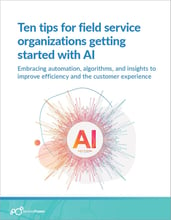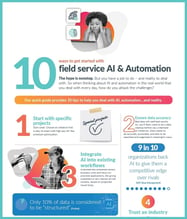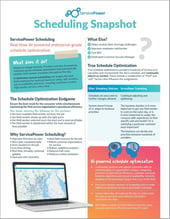AI and Field Service Management Software
What it is & How it Works

Artificial Intelligence and Field Service
The topic of artificial intelligence (AI) is dominating media and social platforms, causing controversy as well as excitement. There is no doubt AI is ushering in a new era of business processes, automating steps, analyzing vast amounts of data, predicting outcomes, prescribing interventions, and generating content. While naysayers may worry about security, the loss of jobs, and the remote possibility of diabolical machines taking over the world, enthusiastic organizations are envisioning new futures.
For field service organizations (FSOs), the role of AI is still being defined. Companies are identifying the tedious internal processes which can be automated and learning how analytics can apply rules-based decision-making to complex tasks. Benefits include cost savings, improving the customer experience, and improving the workplace environment, helping to attract and retain valuable workers, like skilled technicians.
Common Types of AI
Rule-based insights and algorithms can be used to optimize scheduling and dispatch, making sure the right technician is assigned to the right job every time. Field service workers can also use insights to speed call resolution and maintain quality control.
But can organizations expect to transform their operations in one sweeping motion? Not usually. Modern end-to-end software solutions will offer major gains, with built-in AI-driven tools, like automatic matching of purchase orders and invoices, calculations of discounts and commissions, and flags on customer accounts when warranties and service agreements are due to expire. However, teams will also need to be trained and a new mindset has to be adopted by the organization. A new culture that values data-based decision-making and prescriptive insights needs to be nurtured. It seldom happens overnight.
In fact, the learning curve can be steep, with confusion getting in the way of confident adoption of new solutions. Keeping up with the evolving technology and emerging use-cases is no easy feat. There’s a lot to absorb.
The industry buzz is also filled with myths, overhyped promises, and doom-and-gloom dystopian fears, making it difficult to obtain a realistic picture of AI’s current merit. Some vendors are blurring the lines between automation and augmentation. Some may even misrepresent if their solutions “learn” from situations or simply apply existing knowledge. Organizations need to be alert to misinformation and trust only reliable sources for advice. If an offering seems too good to be true, it probably is.
It pays to have a basic understanding of the common types of AI so you can make well-informed decisions about the use of AI in your field service organization and have conversations with peers and vendors feeling confident.
AI Terminology
Here are some of the terms you will likely encounter:
Robotic process automation (RPA). This type of application is used for repetitive and labor-intensive back-office workflows like filling in forms, searching for information, or sorting invoices, explains AWS. Natural language processing (NLP) and optical character recognition (OCR) are often part of the process.
Intelligent automation (IA). Sometimes also called cognitive automation, IA streamlines and scales decision-making. It continuously collects, processes, and analyzes data for you, flagging abnormalities or situations requiring further study, such as a service request that has not yet been assigned to a field worker.
Rule-based automation. It has been used for decades to automate simple processes such as data entry and accounting reconciliation. It can process a myriad of rules at once, far faster than a human and with greater accuracy, since the system is immune to human weaknesses like being tired, bored, or distracted. Rule-based automation is highly effective and reliable, especially in situations where the rules, or conditions, can be clearly defined—like factors influencing route optimization or warranty claim validation.
Machine learning (ML). Machine learning uses the science of statistical models and algorithms to predict outcomes and perform related tasks, as assigned by humans. ML algorithms use large volumes of historical data to train the system on inputs and outputs.
Generative AI. Generative AI can produce various types of content, including text, imagery, audio, and synthetic data.
Large language models (LLMs) allow models with billions or even trillions of parameters.
Field service organizations need to understand the current state of AI capabilities so they can form realistic expectations based on facts, not hype, and take strategic actions. To remain relevant and competitive, FSOs must take advantage of all resources available to them, including AI. Putting off adoption puts the organization at risk of appearing unresponsive to customer expectations and slow to adapt to evolving best practices. Customers notice when service is slow, inconsistent, and inefficient.
AI adoption is steadily gaining momentum. If you are not currently aligned with a strategy for AI adoption, you risk falling behind.
Common AI Applications
Common applications today include:
- Chatbots answer customer online queries, flagging critical inquiries for escalation
- Digital assistants, like Alexa and Siri, answer questions and provide directions
- Accounting programs calculate labor costs and generate invoices
- Field service solutions maintain real-time views of customer purchases, warranties, and service requests
- Schedule optimization assigns service requests to the appropriate technician or other field worker, based on several factors, from the field worker’s location to skill level and experience with the brand needing service
AI Pitfalls
Here are some of the terms you will likely encounter:
Data quality. Data quality needs to be a top priority for the organization. Feeding the system biased or incomplete data will yield faulty results, putting a layer of doubt on all reports and conclusions.
Accuracy. AI tools can generate plausible but factually inaccurate or unrelated outputs, sometimes called hallucinations or confabulations. Humans need to monitor and verify questionable assumptions.
Bias. AI tools can make decisions based on inappropriate, irrelevant criteria, or bias that is unintentionally built in when the system is trained. Bias also becomes a possible factor if the tool wrongly “assumes” a factor like gender or race influences the ability to perform a task well.
Realistic Expectations
What is realistic to expect?
AI is not magic, nor will it replace all humans, or solve all business problems overnight. It is a process of adapting and learning. As service-centric companies seek to improve thin margins and build loyalty among today’s highly demanding customers, every technological advantage is important. But the applications need to be practical, reliable, and easy to execute.
Many use-case examples of AI can be seen today. AI automates tedious data entry and streamlines mundane tasks. The day-to-day operations of many FSOs is clogged with tedious tasks, from ordering and tracking inventory of spare parts to logging miles traveled, updating warranty claims, and making sure each service vehicle is stocked with appropriate parts and tools. AI will help automate those steps. It will also help workers find data they need.
In the service industry, technicians often need to access information about model numbers, compatible parts, suitable replacements, and service history on a particular unit. AI capabilities will help push this type of useful information to the field worker—before the worker initiates a search. This saves time and helps workers follow best practices.
Although the future will be impacted by AI, most experts agree technology won’t be completely replacing humans in the workplace anytime soon. FSOs will still rely on call center agents to give customers personalized attention. Dispatchers will still need to review optimized schedules and handle exceptions. Technicians will still need to travel on-site to make repairs. As the tedious tasks are automated, workers are then freed to focus on higher-value tasks, like building relationships with customers.
Customers today expect a proactive service experience from service providers. Customer service has a positive impact on customer loyalty, repeat sales, and business growth. Modern technologies, with AI built-in, will help organizations up-level their performance. To remain competitive, field service organizations must stay attuned to customer and employee expectations and adopt tools for improving operations.
Adopting AI capabilities is a certain way to modernize and improve efficiency. AI, in its various forms, provides the insights you need to be future-ready.
AI Knowledge Center
Field Service Management Software Demo
Before investing in a field service management solution, it’s important to try out the software for yourself. By requesting a field service software demo, you can experience the interface and functionalities of a specific solution. Ultimately, you want to invest in a solution that is not only intelligent and innovative but also easy for you to use.
Experience ServicePower’s field service management solution for yourself with a custom demo.








